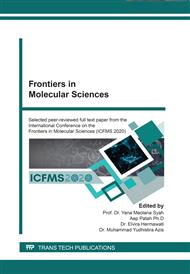[1]
A. Zohra, S. Anwar, A. Fitri, M. Nasution, Klasifikasi Wilayah Provinsi Aceh Berdasarkan Tingkat Kerentanan Kasus Malaria Tahun 2015 – 2018, Jurnal Kesehatan Lingkungan Indonesia. 18 (2019) 25-33.
DOI: 10.14710/jkli.18.1.25-33
Google Scholar
[2]
Ministry of Health, Pedoman Manajemen Malaria (2014).
Google Scholar
[3]
Pan American Health Organization / World Health Organization. Epidemiological Alert: Increase in cases of malaria. Washington, D.C (2017).
Google Scholar
[4]
Surabhi, B. K. Singh, Computer-Aided Drug Design: An Overview, Journal of Drug Delivery & Therapeutics, 8 (2018) 504-509.
DOI: 10.22270/jddt.v8i5.1894
Google Scholar
[5]
M. A. F. Nasution, B. Ardiansah, U. S. F. Tambunan, Chalcone and Its Pyrazole Derivatives as Potential Plasmodium falciparum Lactate Dehydrogenase Inhibitor: In Silico Approach for New Antimalarial Drug, The 1st Asian Researcher Symposium. (2016).
Google Scholar
[6]
A. Hameed,·S. Masood, A. Hameed,· E.Ahmed, A. Sharif, M. I. Abdullah, Anti-malarial, cytotoxicity and molecular docking studies of quinolinyl chalcones as potential anti-malarial agent, Journal of Computer-Aided Molecular Design. 33 (2019) 677-688.
DOI: 10.1007/s10822-019-00210-2
Google Scholar
[7]
J. Syahri, E. Yuanita, B. A Nurrohmah, R. Armunanto, B. Purwono, Chalcone analogue as potent anti-malarial compounds against Plasmodium falciparum: Synthesis, biological evaluation, and docking simulation study, Asian Pacific Journal of Tropical Biomedicine. 7 (2017) 675-680.
DOI: 10.1016/j.apjtb.2017.07.004
Google Scholar
[8]
J. Syahri, K. Rullah, R. Armunanto, E. Yuanita, B. A. Nurrohmah, M. F. F. M. Aluwi, L. K. Wai, B. Puwono, Synthesis, biologi evaluation, QSAR analysis, and molecular docking of chalcone derivatives for antimalarial activity, Asian Pacific Journal of Tropical Disease. 7 (2017) 8-13.
DOI: 10.1016/j.apjtb.2017.07.004
Google Scholar
[9]
M.E. De Oliveira, G. Cenzi, R.R. Nunes, C. R. Andrighetti, D.M. De Sousa Valadão, C., Dos Reis, C. M. O. Simões, R. J. Nunes, M. C. Júnior, A. G. Taranto, B. A. M. Sanchez, G. H. R. Viana, F. De Pilla Varotti, Antimalarial Activity of 4-Metoxychalcones: Docking Studies as Falcipain/Plasmepsin Inhibitors, ADMET and Lipophilic Efficiency Analysis to Identify a Putative Oral Lead Candidate, Molecules. 18 (2013) 15276-15287.
DOI: 10.3390/molecules181215276
Google Scholar
[10]
R. Pingaew , A. Saekee, P. Mandi, C. Nantasenamat, S. Prachayasittikul, S. Ruchirawat, V. Prachayasittikul, Synthesis, biological evaluation and molecular docking of novel chalcone-coumarin hybrids as anticancer and antimalarial agents, Eur J Med Chem. 6 (2014) 65-76.
DOI: 10.1016/j.ejmech.2014.07.087
Google Scholar
[11]
M. Thillainayagam, L. Pandian, K. K. Murugan, V. Vijayaparthasarathi, S. Sundaramoorthy, A. Anbarasu, S. Ramaiah, In silico analysis reveals the anti-malarial potential of quinolinyl chalcone derivatives, Journal of Biomolecular Structure and Dynamics. 33 (2015) 961-977.
DOI: 10.1080/07391102.2014.920277
Google Scholar
[12]
M. Thillainayagam, K. Malathi, S. Ramaiah, In-Silico molecular docking and simulation studies on novel chalcone and flavone hybrid derivatives with 1, 2, 3-triazole linkage as vital inhibitors of Plasmodium falciparum dihydroorotate dehydrogenase, Journal of Biomolecular Structure and Dynamics. 36 (2018) 3993-4009.
DOI: 10.1080/07391102.2017.1404935
Google Scholar
[13]
W. Humphrey, A. Dalke, Schulten, K., VMD - Visual Molecular Dynamics,, J. Molec. Graphics. 14 (1996) 33-38.
DOI: 10.1016/0263-7855(96)00018-5
Google Scholar
[14]
W. L. DeLano, Pymol: An open-source molecular graphics tool. CCP4 Newsletter On Protein Crystallography. 40 (2002) 82-92.
Google Scholar
[15]
ChemAxon, Marvin 18.28.0, 2018 , (http://www.chemaxon.com).
Google Scholar
[16]
G. M. Morris, R. Huey, W. Lindstrom, M. F. Sanner, R. K. Belew, D. S. Goodsell, A. J. Olson, Autodock4 and AutoDockTools4: automated docking with selective receptor flexiblity, J. Computational Chemistry. 16 (2009) 2785-91.
DOI: 10.1002/jcc.21256
Google Scholar
[17]
BIOVIA, D. S.. Discovery studio modeling environment. San Diego, Dassault Systemes, Release, 19.0 (2019).
Google Scholar
[18]
D. Simamora, L. E. Fitri, Antimalarial Drug Resistance: Mechanism and The Role of Drug Combination in Preventing It, Jurnal Kedokteran Brawijaya. XXIII (2007) 82-89.
Google Scholar


